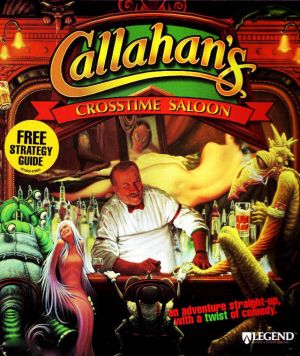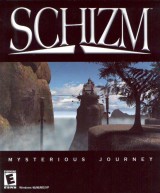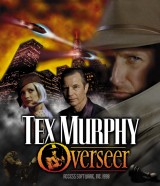Review for Callahan’s Crosstime Saloon
Even if you know Long Island like the back of your hand, you're bound to miss Callahan's Crosstime Saloon, an unassuming place tucked into the woods on a quiet stretch of Route 25A. I would have missed it myself if a friend hadn't pointed it out. It's not a well-known establishment but it draws its fair share of loyal eccentrics, and Mike Callahan and his patrons wouldn't have it any other way. The first night I stepped into Callahan's, I was greeted by a regular named Jake Stonebender, a long-haired folk singer dressed in plaid flannel. He bought me a drink and invited me to stick around for what promised to be a rowdy Riddle Night. Jake, as it turned out, was on the verge of a busy night himself, and I was lucky enough to tag along for the ride.
Callahan's Crosstime Saloon, a 1997 release written by Sierra veteran Josh Mandel and developed by now-defunct Legend Entertainment, is an adaptation of Spider Robinson's science fiction stories about Jake Stonebender and his friends at Callahan's. The game opens outside our galaxy, in an It's A Wonderful Life-style conversation between two pulsing zephyrs of light. Turns out the universe is about to be shut down for lack of funding (sounds like a lot of adventure games these days!) and its creator is desperate to find something unique enough about the human race to justify keeping the project alive. This crisis takes a back seat, however, as we zoom down on Callahan's, where our hero Jake has just arrived for the evening.
Little does Jake know, he's in for a long one. His friends keep asking for favors, and Jake's too nice a guy to say no. Before the night is out, he'll take on an alien race that's sapping the world of testosterone, travel into the Brazilian jungle to save an endangered strain of orgasmic chocolate from extinction, set out for Transylvania to rescue a lovesick vampire from himself, plot to spring a four-legged friend from a remote government research facility, and zip into a not-too-distant future Manhattan to secure a much-needed medicine for a desperate friend… not to mention finding a solution for that intergalactic budget crisis looming overhead. It's a tall order for one night. Luckily, Callahan keeps the taps flowing.
Callahan's Crosstime Saloon has a hub-and-spokes construction, with Jake returning to the bar for a drink and some conversation between each of his quests. This setup gives the game a nice rhythm. Each of the six quests took me at least a couple hours to puzzle through, but since they're self-contained, I didn't run into the problem of stepping away from the game for a few days and forgetting what happened the last time I played. There's some flexibility in the order in which the quests are performed, but they must all be completed to finish the game. And once you've started a quest you have to finish it; you can't hop from one to another.
Each time Jake makes it back to Callahan's, he's greeted with toasts, puns, and banter from a group of close-knit, loyal friends. This camaraderie sets Callahan's apart from many adventure games that send the protagonist on an isolated journey through unfamiliar terrain. Although Jake is often faced with the unfamiliar, he's also given the chance to touch base and swap jokes with people he knows and likes. This strong sense of community goes a long way toward making his character believably human and Callahan's Crosstime Saloon a lot less lonely than the average adventure game experience. And these friendships don't stop in the bar. On most of Jake's quests, another patron comes along to keep him company and, when Jake asks, lend a hand… or at the very least, a well-phrased hint.
The game is in first-person perspective, with a node-based 360-degree panoramic view. When you move the cursor to the edge of the screen, it becomes an arrow to indicate there's more to see in that direction. Left-clicking pans in the direction of the arrow and right-clicking jumps 90 degrees. The graphics are detailed and somewhat realistic, with some characters and backgrounds looking almost like FMV captures, but they're also very flat, with characters standing stiffly like cardboard cutouts against static backgrounds. Most of the game's action is described through on-screen text, instead of being acted out. In fact, other than a few movies and lip-syncing on the dialogue portraits, there's not much animation at all. The world is so vividly portrayed in the text, though, I hardly missed it.
Although the game is narrated with text, the characters are all voice acted. Headshots of Jake and his companion, when he has one, are displayed at the bottom of the screen, eliminating the disembodied feeling you get with some first-person games. During conversations, a screen comes up displaying a conversation tree alongside larger pictures of Jake and whomever he's talking to (similar to how dialogue trees were handled in the first Gabriel Knight game). There's a lot of optional dialogue here, and it's often quite funny, but the multiple branches on the dialogue trees sometimes led me to miss bits of crucial information buried deep in the conversation.
The gameplay involves a lot of talking to others, picking up and looking at inventory items, and hearing/reading what Jake and the narrator think about the environment—often with really funny results. This constant commentary is another way Callahan's differs from many other first-person games. I haven't read the source material, but some passages of narration seem like they came straight out of a short story. The high level of interactivity with the environment gives the world a complete feel. It may not be fair to compare a game based on published fiction to other games that aren't, but I wish more developers knew their worlds as well, and made them as accessible to the audience as Josh Mandel has with this one.
Callahan's is point & click all the way, and there's plenty to point at and click on. Just by moving your cursor around any scene, you'll hit over a dozen hotspots. When you move over a hotspot, a description comes up, along with a list of actions you can perform (such as look at, take, shake, eat, or move). Some hotspots have three or four actions available (and some as many as twelve), most of which just bring up a funny response. There's tons of optional description waiting to be triggered, but I didn't find myself cursing all the extra things I could do. In Callahan's, there's a real payoff for clicking on things and engaging people in conversation—humor. The folks at Callahan's are very fond of puns and wordplay. They're quick with one-liners, and the constant banter reinforces that these people are good friends. Although some of the humor is dated, referring to mid-90s politics and pop culture, the majority has withstood the test of time surprisingly well.
Most of the puzzles are familiar adventure game fare, and except for a few pixel hunts, gameplay is not exceedingly difficult. But in addition to more familiar inventory, dialogue, and mechanical challenges, this game has another, unique type of task: the wordplay puzzle. The game's opening puzzle involves solving ten riddles that have been written out on a chalkboard—the kind of "theme night" activity you might find in any neighborhood bar. Each riddle contains a collection of seemingly random words. You have to think of synonyms for those words that, when strung together, sound like a phrase or person's name. The answers to all the riddles on the chalkboard fall into the same category, so once you guess one it's a little easier to figure out the others. If you walk around the bar, other patrons will give you clues, and Mike Callahan will even inadvertently give a few answers if you engage him in conversation. Still, these are going to be hard for people who don't know much about the category, which relates to American pop culture. There's another Riddle Night later in the game, as well as a few other puzzles that involve similar types of wordplay, and they're all required to move forward. They might be frustrating for some players, especially those who are not native English speakers. On the plus side, it's really obvious when these puzzles occur, so you'll be able to check a walkthrough and move on without wasting too much time.
Callahan's is a comedy, but with serious undertones. On the surface, Jake is a good Samaritan who goes out of his way to help his friends, but he's also suppressing a painful secret from his past. This secret is only hinted at for most of the game, then finally revealed so simply, yet so powerfully, it brought tears to my eyes. I didn't feel at all manipulated, like I do after some sweepingly dramatic cutscenes in games like Syberia—you know, those scenes you hate yourself for crying at because you know that's exactly what the developer wants from you. No, this moment was much quieter, and as a result much more poignant. And that was it. Rather than have that tragedy become the game's focus, Legend made the wise choice to fade it into the background, sending Jake back to his friends at the bar. It made me think about human nature; how behind all the laughter even the cheeriest person can be hiding incredible pain. It's only a small part of the game, but the moment is handled perfectly, and is one of the scenes that stood out most.
Like many of the bar's patrons, if you want to pay a visit to Callahan's, you'll have to do a little time travel. The game installed fine on Windows XP but I ran into sound problems, even with VDMSound. In DOSBox it was extremely sluggish. So if you plan to play Callahan's on a newer machine, be prepared to do a bit of tinkering. It worked best for me on an old computer running Windows 98. I still heard some static and a few high-pitched beeps during dialogue, but there were no crashes or problem areas. (I found out after I played that a patch is available. It's supposed to fix some dialogue issues and other bugs. The patch is available for download from Gamespot. It appears to make saved games unusable, so best to install it before you start playing.)
A lot has changed since 1997. These days, when games are announced on the web long before screenshots even exist and so many cookie-cutter clones make it on to store shelves, it's rare for a game to be truly surprising. Callahan's Crosstime Saloon was one of those unexpected games for me. I knew very little about it going in (less than you do, having read this review). In fact, I wouldn't have played the game at all if not for a gesture of kindness from a community member—a show of friendship, it turns out, that is very much in line with Callahan's themes. The game is a true gem, and it's a shame that now, nearly ten years after its release, it's so hard to find. The right thing to do would be for me to continue this legacy of friendship and pass my copy on to someone else who hasn't played it, but I enjoyed it too much to part with it just yet. I'll get back to you in another ten years.
Our Verdict:
Callahan's is a place where humor is king, the drinks flow freely, and friendship is cherished above all else. If you can find your way over there, it's well worth the trip. Tell Mike Callahan I sent you, and say hi to Jake and the gang for me.




























